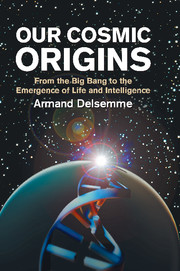Book contents
- Frontmatter
- Contents
- Foreword
- Preface
- Acknowledgments
- 1 Locating humans in the Universe
- 2 The race toward complexity
- 3 The stellar alchemy of metals
- 4 The formation of the planets
- 5 The emergence of life
- 6 The history of life
- 7 The awakening of intelligence
- 8 The other worlds
- 9 Perspectives
- APPENDIX A The standard model of the physics of elementary particles
- APPENDIX B Symmetry in physics
- APPENDIX C The strange role of time in relativity
- APPENDIX D The measurement of long time spans and the age of the Universe
- APPENDIX E The standard model of the Big Bang
- APPENDIX F The cause of the Big Bang and inflation
- APPENDIX G Chirality
- Glossary
- Bibliography
- Figure index
- Table index
- Name index
- Subject index
3 - The stellar alchemy of metals
Published online by Cambridge University Press: 05 August 2012
- Frontmatter
- Contents
- Foreword
- Preface
- Acknowledgments
- 1 Locating humans in the Universe
- 2 The race toward complexity
- 3 The stellar alchemy of metals
- 4 The formation of the planets
- 5 The emergence of life
- 6 The history of life
- 7 The awakening of intelligence
- 8 The other worlds
- 9 Perspectives
- APPENDIX A The standard model of the physics of elementary particles
- APPENDIX B Symmetry in physics
- APPENDIX C The strange role of time in relativity
- APPENDIX D The measurement of long time spans and the age of the Universe
- APPENDIX E The standard model of the Big Bang
- APPENDIX F The cause of the Big Bang and inflation
- APPENDIX G Chirality
- Glossary
- Bibliography
- Figure index
- Table index
- Name index
- Subject index
Summary
Matter is made of four elements: Earth, Water, Air and Fire.
Empedocles, c. 450 BC, quoted in Encyclopedia BritannicaIn the Earth's interior, the transmutations of the 4 elements produce 2 exhalations: the dry one separates fire from stones, the moist one separates steam from metals.
Aristotle, c. 360 BC, quoted in Encyclopedia BritannicaWater is the base of metals like silver and gold, Earth, that of stones, whether precious or common; the solidification of metals is due to heat; that of stones, to cold.
Theophrastus, c. 300 BC, quoted in Encyclopedia BritannicaThe life of the stars
At the time when the first quasars showed their dazzling brilliance, there were still no atoms of carbon, nitrogen, or oxygen, no metals in the Universe, nor any solid stuff (earth, rocks, etc.). It is tempting to think that the extreme temperatures reached in the accretion disks of quasars would have already produced new elements. But we must remember that the rings that reached a sufficiently high temperature were eventually absorbed by the black hole and disappeared from our Universe before having had a chance to make complex molecules.
The first stars formed out of a gaseous mixture of about 76% hydrogen and 24% helium, plus a few traces of rare light elements, such as lithium, or rare isotopes like deuterium or 3He. Table 3.1. Major thermonuclear reactions within stars, classified by increasing ignition temperature, from 10 million degrees for hydrogen, up to 6 billion degrees for iron
The minimum stellar mass able to reach this ignition temperature is indicated in solar mass units M⊙.
- Type
- Chapter
- Information
- Our Cosmic OriginsFrom the Big Bang to the Emergence of Life and Intelligence, pp. 43 - 68Publisher: Cambridge University PressPrint publication year: 1998



